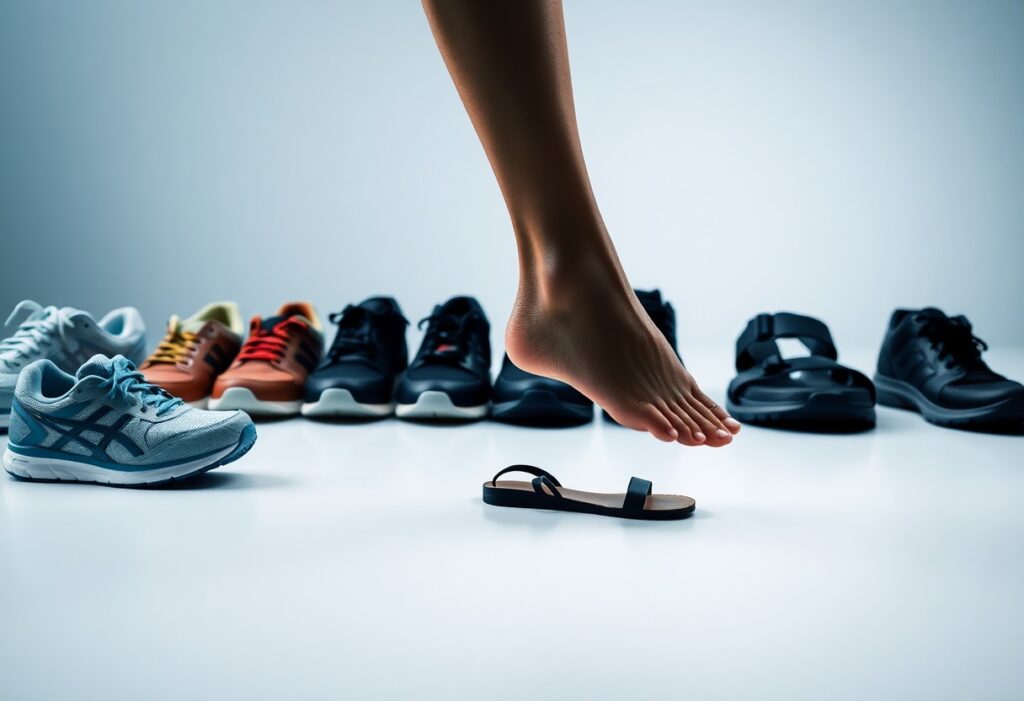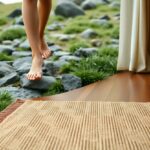
As you walk, the type of footwear you choose can either significantly enhance or detrimentally affect your foot health. Many individuals may believe that shoes with increased cushioning and support are the ultimate solution to foot discomfort; however, traditional shoes often do more harm than good. Dr. Alissa Kuizinas, a renowned podiatrist from Massachusetts, advocates for barefoot shoes or minimalistic footwear, suggesting they promote stronger and healthier feet. By selecting footwear that allows your feet to operate naturally, you can reduce the likelihood of developing various foot issues and enhance your overall foot wellness.
Recognizing the Detrimental Effects of Conventional Shoe Designs
While conventional shoes may provide temporary relief for foot pain, they often worsen existing ailments and introduce new complications, as highlighted by Dr. Alissa Kuizinas. She emphasizes that the $133 billion shoe industry frequently prioritizes aesthetics and profitability over genuine foot health, resulting in designs that can constrain and weaken your feet over time. This reliance on traditional footwear can create a cycle of dependency that ultimately compromises your foot health and function.
Unpacking the Shoe Industry’s Flawed Approach to Foot Health
At the core of this dilemma lies the shoe industry’s misguided approach to addressing foot health, which often emphasizes the incorporation of excessive cushioning, support, and rigid construction into footwear without tackling the underlying causes of discomfort. This strategy can foster a reliance on traditional shoes that may ultimately deteriorate your foot health over time, leading to various complications that could have been avoided with better shoe design.
Examining the Shortcomings of Traditional Shoe Features
Traditional shoe designs frequently feature narrow toe boxes, inflexible soles, and excessive cushioning, all of which can hinder natural foot movement, ultimately resulting in weak and dysfunctional feet. Dr. Kuizinas asserts that footwear should protect your feet from external elements, rather than restrict their natural movement. A well-designed shoe must prioritize natural foot function and minimalist attributes, such as broad toe boxes, flexible and flat soles, and minimal cushioning to truly foster foot health and well-being.
By opting for barefoot shoes or minimalistic footwear, you can actively strengthen your feet and enhance your overall foot well-being. Dr. Kuizinas promotes a philosophy of utilizing as little shoe as possible, allowing your feet to function naturally and move freely, which is crucial for maintaining healthy foot mechanics and preventing future issues.
The Essential Importance of Natural Foot Movement for Health
Footwear that restricts your foot’s ability to move freely can lead to a variety of foot issues and discomfort. Therefore, it’s essential to evaluate how your choice of shoes impacts your overall foot health and comfort levels, as these factors are interconnected and influence your physical activity.
Understanding How Shoes Affect Your Foot Mobility and Function
To fully comprehend how shoes impact your foot’s ability to move effectively, it’s crucial to analyze the specific design and characteristics of your chosen footwear. Traditional shoes often contain cushioning and support features that can actually impede your foot’s natural movement, leading to weak and dysfunctional feet over time. This restriction can prevent your feet from developing the necessary strength and flexibility they require for optimal health.
Unlocking the Benefits of Allowing Natural Foot Mobility
The benefits of allowing your feet to move freely are extensive, as strong feet are fundamental to overall foot health. By choosing minimalistic shoes or barefoot footwear, you empower your feet to perform naturally, thereby encouraging strength and resilience in your foot structure.
Movement is essential for developing strong feet. When restricted by conventional footwear, you risk the development of various foot problems and discomfort. Conversely, embracing minimalistic shoes or barefoot options can significantly enhance your foot health by permitting natural movement and facilitating strength-building in the muscles of your feet. By selecting the right footwear, you can lower your risk of developing foot issues and promote your overall foot wellness.
Defining the Concept of Functional Footwear and Its Benefits
Gaining a thorough understanding of functional footwear is crucial, as these shoes prioritize both foot health and natural movement. Functional shoes are specifically designed to allow your feet to operate as intended, negating the need for excessive support or confinement that often accompanies traditional designs.
Key Characteristics of Functional Shoes for Optimal Foot Health
Upon conducting research and experimenting with various shoe styles, you’ll discover that functional footwear possesses unique characteristics, including a wide toe box, flat and flexible soles, along with minimal cushioning and support. These attributes empower your feet to move freely and naturally, fostering stronger and more capable mechanics that promote overall foot health.
Enhancing Foot Health Through Functional Shoe Design
Wearing functional shoes provides numerous advantages, such as improved foot strength, a diminished risk of injury, and enhanced overall foot health. These shoes facilitate your feet in functioning as they were naturally intended, paving the way for stronger feet and better balance in your daily activities.
Conceptually, functional footwear is crafted to support your feet without imposing unnecessary restrictions, enabling them to move and flex naturally. This design philosophy promotes optimal foot health and minimizes the likelihood of developing foot ailments. By choosing functional shoes like barefoot shoes or minimalistic options, you actively encourage healthy foot function and mitigate the risk of foot pain and injury. Transitioning to functional footwear may require patience and gradual adjustment, but the long-term benefits for your foot health are invaluable.
Recognizing Essential Features of Functional Footwear
To achieve optimal foot health, it’s essential to seek out shoes equipped with particular features. The key attributes to consider when selecting footwear include:
- Wide toe box
- Flat and flexible soles
- Minimal cushioning and support
Being aware of these characteristics will significantly aid you in selecting shoes that foster healthy foot function and support while avoiding unnecessary complications.
The Significance of Wide Toe Boxes and Flexible Soles in Footwear
A critical feature of functional shoes is a wide toe box, which allows your toes to spread naturally. This design helps prevent toe jamming and other discomfort-related issues that could lead to chronic foot pain and mobility limitations.
Understanding the Necessity of Minimal Cushioning and Support
In addition to a wide toe box, functional shoes should feature minimal cushioning and support. This design element allows your feet to move naturally while strengthening foot muscles, thereby reducing the risk of foot issues and enhancing overall foot function.
It’s essential to highlight that minimalistic footwear, including barefoot shoes, can greatly benefit your foot health by enabling your feet to function freely. By opting for shoes with minimal cushioning and support, you can enhance muscle strength in your feet and lower the chances of injuries. This strategic approach not only improves your overall foot health but also decreases the likelihood of experiencing chronic pain. Therefore, you should prioritize shoes that allow your feet to move naturally without excessive cushioning or support.
How to Transition to Functional Footwear for Better Foot Health
Having recognized the importance of functional footwear, it’s time to embark on your transition. Contrary to the common belief that more cushioning and support equals better comfort, you should opt for minimalistic shoes or barefoot shoes that facilitate your feet’s natural functioning and promote healthy mechanics.
Practical Steps for a Smooth Transition to Functional Footwear
Despite any reservations you may have, begin incorporating functional shoes into your daily life with these practical tips:
- Start with brief walks and progressively extend the distance as your feet adapt
- Select shoes featuring a wide toe box and flat soles to support natural movement
- Opt for minimal cushioning and support to allow your feet to strengthen
The essential aspect is to allow your feet time to adjust to the new shoes while building the muscles in your feet, promoting better health.
Emphasizing the Importance of Patience During Your Transition
Transitioning to functional footwear requires patience and a gradual approach. Shoes that are overly minimalist can result in discomfort and pain if your feet are not accustomed to them. Starting slowly is key, allowing your feet to acclimate to the new footwear without experiencing undue stress.
Footwear options like barefoot shoes or minimalistic shoes can be immensely beneficial for your foot health, but it’s vital to introduce them gradually. Overuse or improper sizing can lead to injuries or persistent discomfort. The ultimate goal is to strengthen your foot muscles while enhancing your overall foot health, so be patient and avoid rushing through the process. The rewards will be significant; expect to experience improved balance, less pain, and stronger feet as you progress.
Building Strong and Functional Feet for a Healthier You
Even in a world where wearing shoes with excessive cushioning and support is the norm, you can cultivate strong and functional feet by selecting the right footwear that aligns with your body’s natural mechanics.
Understanding the Connection Between Foot Strength and Overall Health
In conjunction with other health factors, foot strength plays a pivotal role in your overall well-being, influencing your balance, posture, and movement capabilities. Strong feet are foundational to maintaining good physical health and preventing injury.
How Functional Footwear Supports the Development of Strong Feet
Functionally designed shoes that feature a wide toe box, flat and flexible soles, and minimal cushioning are essential in developing strong feet, as they allow for natural movement and function.
Indeed, wearing functional shoes or barefoot shoes can significantly aid in building stronger foot muscles and enhancing your overall foot health. By granting your feet the freedom to move and operate naturally, you can minimize the risk of foot problems and optimize your balance and stability. As you make the switch to minimalistic shoes, expect to see improvements in your walking technique and your overall sense of well-being as your feet grow stronger.
By taking charge of your foot health, you can select shoes that complement your feet’s natural functions rather than hinder them. Opting for barefoot shoes or minimalistic options that allow your feet to operate naturally will facilitate strength development over time. In doing so, you’ll enjoy increased stability and comfort during activities, granting your feet the opportunity to grow strong and capable. Start your journey by seeking shoes with a wide toe box, flat and flexible soles, and minimal cushioning and support, and exercise patience as you transition to a more natural walking style that promotes overall wellness.
The Article A Podiatrist’s Guide to How Shoes Affect Your Foot Health appeared first on My Shoes Finder
The Article How Shoes Impact Your Foot Health: A Podiatrist’s Insights Was Found On https://limitsofstrategy.com






Comments are closed